#Release date: December 1975
Text
(Doctor Who) UK Prime Ministers and US Presidents
Full (Incomplete) UK PM List in the DWU from 1950 – 20XX (Some years are guessed)
Will be updated whenever I can be bothered we get new information. Just random speculation jamming together a list that was never meant to be jammed together.
Historical Before This Point
Winston Churchill (1951-1955)
Anthony Eden (1955-1957)
Harold Macmillan (1957-1963)
Sir Alec Douglas-Home (1963-1964)
Harold Wilson (1964-1970)
Edward Heath (1970-1972)
Jeremy Thorpe (1972-1974)
Harold Wilson (1974-1975)
Brenda Jones (1975) (According to a Jonathan Morris Tweet)
Shirley Williams (1975-1976)
James Callaghan (1976-1979)
Margaret Thatcher (1979-1990)
Margery Phipps (1990-1992)
John Major (1992-1997) (Assassinated)
Lord Greyhaven (1997) (De Facto PM for several weeks)
Tony Blair (1997-1999)
Terry Brooks (1999-2000)
Phillip Cotton (2000) (Deputy PM until election was called)
Kenneth Clarke (2000-2001)
Tony Blair (2001-2002) (Second term)
Unnamed Male Pro-Europe PM (Possibly Hugh Grant) (2002-2005)
Tony Blair (2005-2006) (Third term)
Joseph Green/Jocrassa Fel-Fotch Passameer-Day Slitheen (2006) (Only served as acting PM for a day)
Harriet Jones (2006-2008)
Harold Saxon (2008)
Aubrey Fairchild (2008-2009)
Brian Green (2009-2010)
Unnamed Female Prime Minister (2010-2013)
Kenneth LeBlanc (2013)
Unnamed Female Prime Minister (2013-2014) (Resumed for a second term after Kenneth Le Blanc died)
David Cameron (2014-2015)
Daniel Claremont (2015)
Theresa May (2015-2018)
Felicity (2018-2019)
Fiona (2019-2020)
Boris Johnson (2020-2021) (Revealed to be an Auton)
Jo Patterson (2021)
Edward Lawn Bridges (2021-2023)
Unnamed Woman (2023-2025)
S J Wordley (2025-2026)
Glenda Jackson (2026-2028)
The Director (2028-2046)
Dai (2047-2049)
Lomax (2049 - 2050)
Mariah Learman (2050-2055)
Unnamed (?-2065-?)
Corollaries (PM List)
Jeremy Thorpe and Shirley Williams are said to be Prime Minister contemporaneously with the UNIT stories (Which are assumed here to take place on their airdates as per Mawdryn Undead and most Modern Who references)
In a tweet Jonathan Morris claimed the Prime Minister in Terror of the Zygons or Mawdryn Undead was Brenda Jones, Harriet Jones' auntie. I put this in 1975 (for less than a year) because why not. Ignore this if you think it's bad.
Actual dates of Kenneth Le Blanc and Unnamed Female PM are unknown, but are set in the UNIT audios between Power of Three (2012-2013) and DotD (2013).
Felicity and Fiona are given as PMs in Aliens Among Us and God Among Us (Torchwood S5 and S6) released and presumably set in 2018 and 2019 respectively.
Eight gives the PM list as Heath -> Thorpe -> Williams -> Thatcher -> Major -> Blair -> Clarke in Interference, this is not supported as a direct list by other sources, though I tried to fit it as best I could, resulting in Blair having two non-adjacent terms.
2010s are a mess due to BF, Titan Comics and the Lucy Wilson novels all giving conflicting accounts of who is PM only a couple years apart, apparently there were a lot of elections/resignations in that decade
Harriet Jones initially served Three terms prior to the Doctor altering history and deposing her, given UK Term Length is unclear, it's unknown how long this would have been, I would guess around 15 years, which would've put Harriet Jones at (2006-2021) where she'd be succeeded by Jo Patterson.
The UK becomes a military Dictatorship from 2028 until 2046 headed by ‘The Director’.
Dai is the first PM after the director, then in 2050 Lomax is the dictator of the UK. In the 'mid 21st Century', Mariah Learman is a ‘benevolent dictator’ of the UK.
An unknown Prime Minster led the UK during the weather crisis of December 2065.
Full (Incomplete) US President List in the DWU from 1960 – 20XX (Some years are guessed)
Historical Before This Point
John F Kennedy (1961-1963) (assassinated)
Lyndon Johnson (1963-1969) (VP who succeeded their predecessor)
Richard Nixon (1969-1974)
Gerald Ford (1974-1977) (VP who succeeded their predecessor)
Jimmy Carter (1977-1981)
Ronald Reagan (1981-1989)
George H.W. Bush (1989-1993)
Carrol (1993-1994)
Bill Clinton (1994-1997) (Presumably VP who succeeded their predecessor)
Tom Dering (1997-1999)
George W Bush (1999-2001) (Presumably VP who succeeded their predecessor)
Bruce Springsteen (2001-2003)
Chuck Norris (2003-2005) (VP who succeeded their predecessor)
George W Bush (2005-2007)
Arthur Coleman Winters (2007-2008) (VP who succeeded their predecessor)
Winter’s VP/Speaker of the House (2008-2009) (Succeeds Winters after he’s killed by Saxon)
2009-2017 Term
Felix Mather (2009-2017) (Presidency overwritten by Faction Paradox)
Sampson (2009-2017) (Presidency induced as an aberration by Lolita)
Barack Obama (2009-2017) (Replaced Felix Mather in history)
2017-2021 Term
Daniel Strunk (2017-2021) (Presidency overwritten by Faction Paradox – Mather’s Successor)
Matt Nelson (2017) (Presidency induced as an aberration by Lolita – Assassinated at Inauguration)
Lola Denison/Lolita (2017-unknown) (Assassinated her predecessor)
Donald Trump (2017-2021) (Replaced Daniel Strunk in history)
After 2021
Courtney Woods (unknown-2049-unknown)
Gavin A32X40 (unknown – 2086 – unknown)
Corollaries (President List)
The Eighth Doctor gives the list of Presidents as Carter -> Reagan -> (HW) Bush -> Clinton -> Dering -> Springsteen -> Norris
The President given in 2004 is referred to by the nickname ‘Chuck’ in Cat’s Cradle: Warhead which combined with the fact Springsteen was the President in 2003 and ‘Norris’ succeeded them suggests that the 2004 President was Chuck Norris.
The President in 2006 was implied to be George W Bush based on Harriet Jones’s dialogue. He was previously stated to be President in 2000 (Which he hadn’t been in real life)
Clinton is stated to be President in both 1997 (by metaphor in Placebo Effect) and in 1999 (in Rosa). However both of these are less conclusive than Tom Dering’s direct appearances in Option Lock and and Millennium Shock (also 1997 and 1999) implying that the mentions in Placebo Effect and Rosa were merely off by 1-3 years.
Obama is explicitly stated and shown to be President in 2009, 2012 and 2016, however Felix Mather is stated to be President in the 2010s, physically meeting the Eighth Doctor in Trading Futures. It is stated that Mather’s role in history was replaced due to Mather refusing to make a deal with Faction Paradox and so that has been taken into account.
Concerning the 2017-2021 Presidential Term
Donald Trump is stated to be a candidate in 2016 and is subsequently stated to be President in 2017, 2018 and 2020.
In contradiction, Daniel Strunk is stated to be President in 2017.
This is resolved by having Strunk be Mather’s successor who’s term was also replaced when Faction Paradox remove Mather’s term from history.
The Faction Paradox novel ‘Head of State’ depicts a 2 term Democratic President named Samson who is succeeded by Matt Nelson of a newly formed Radical Party. They are subsequently assassinated by their VP, the sentient humanoid TARDIS Lolita (Who has also been War Queen of Gallifrey and Queen of the UK before, as well as having devoured the Eleven Day Empire). It’s unknown how long she served nor when beyond ‘Early 21st Century’. She (along with Matt Nelson and Samson) have been as a temporal aberration replacing Mather and Strunk before themselves being replaced by Obama and Trump following Lolita’s defeat in True History of Faction Paradox and the ending of the War in Heaven.
A 2000 Bernice Summerfield short story claims Hillary Clinton was US President at some point. However, these records are portrayed as suspect with Bernice questioning them herself and have been ignored for lack of a position to place Clinton into the timeline.
#doctor who#dweu#doctor who eu#faction paradox#uk prime minister#us president#prime minister#president#in doctor who though#will update
23 notes
·
View notes
Text
Cancelled Missions: NASA's October 1977 Space Shuttle Flight Itinerary
"Soon after President Richard Nixon gave his blessing to the Space Shuttle Program on January 5, 1972, NASA scheduled its first orbital flight for 1977, then for March 1978. By early 1975, the date had slipped to March 1979. Funding shortfalls were to blame, as were the daunting engineering challenges of developing the world's first reusable orbital spaceship based on 1970s technology. The schedule slip was actually worse than NASA let on: as early as January 32, 1975, an internal NASA document (marked 'sensitive') gave a '90% probability date' for the first Shuttle launch of December 1979.
In October 1977, Chester Lee, director of Space Transportation System (STS) Operations at NASA Headquarters, distributed the first edition of the STS Flight Assignment Baseline, a launch schedule and payload manifest for the first 16 operational Shuttle missions. The document was in keeping with NASA's stated philosophy that reusable Shuttle Orbiters would fly on-time and often, like a fleet of cargo airplanes. The STS Utilization and Operations Office at NASA's Johnson Space Center (JSC) in Houston had prepared the document, which was meant to be revised quarterly as new customers chose the Space Shuttle as their cheap and reliable ride to space.
The JSC planners assumed that six Orbital Flight Test (OFT) missions would precede the first operational Shuttle flight. The OFT flights would see two-man crews (Commander and Pilot) put Orbiter Vehicle 102 (OV-102) through its paces in low-Earth orbit. The planners did not include the OFT schedule in their document, but the May 30, 1980 launch date for their first operational Shuttle mission suggests that they based their flight schedule on the March 1979 first OFT launch date.
Thirteen of the 16 operational flights would use OV-102 and three would use OV-101. NASA would christen OV-102 Columbia in February 1979, shortly before it rolled out of the Rockwell International plant in Palmdale, California.
As for OV-101, its name was changed from Constitution to Enterprise in mid-1976 at the insistence of Star Trek fans. Enterprise flew in Approach and Landing Test (ALT) flights at Edwards Air Force Base in California beginning on February 15, 1977. ALT flights, which saw the Orbiter carried by and dropped from a modified 747, ended soon after the NASA JSC planners released their document.
The first operational Space Shuttle mission, Flight 7 (May 30 - June 3, 1980), would see Columbia climb to a 225-nautical-mile (n-mi) orbit inclined 28.5° relative to Earth's equator (unless otherwise stated, all orbits are inclined at 28.5°, the latitude of Kennedy Space Center in Florida). The delta-winged Orbiter would carry a three-person crew in its two-deck crew compartment and the bus-sized Long Duration Exposure Facility (LDEF) in its 15-foot-wide, 60-foot-long payload bay.
Columbia would also carry a 'payload of opportunity' - that is, an unspecified payload. The presence of a payload of opportunity meant that the flight had available excess payload weight capacity. Payload mass up would total 27,925 pounds. Payload mass down after the Remote Manipulator System (RMS) arm hoisted LDEF out of Columbia's payload bay and released it into orbit would total 9080 pounds.

A page from the STS Flight Assignment Baseline document of October 1977 shows payloads and other features of the first five operational Space Shuttle missions plus Flight 12/Flight 12 Alternate
During Flight 8 (July 1-3, 1980), Columbia would orbit 160 n mi above the Earth. Three astronauts would release two satellites and their solid-propellant rocket stages: Tracking and Data Relay Satellite-A (TDRS-A) with a two-stage Interim Upper Stage (IUS) and the Satellite Business Systems-A (SBS-A) commercial communications satellite on a Spinning Solid Upper Stage-Delta-class (SSUS-D).
Prior to release, the crew would spin the SBS-A satellite about its long axis on a turntable to create gyroscopic stability and raise TDRS-A on a tilt-table. After release, their respective solid-propellant stages would propel them to their assigned slots in geostationary orbit (GEO), 19,323 n mi above the equator. Payload mass up would total 51,243 pounds; mass down, 8912 pounds, most of which would comprise reusable restraint and deployment hardware for the satellites.
The TDRS system, which would include three operational satellites and an orbiting spare, was meant to trim costs and improve communications coverage by replacing most of the ground-based Manned Space Flight Network (MSFN). Previous U.S. piloted missions had relied on MSFN ground stations to relay communications to and from the Mission Control Center (MCC) in Houston. Because spacecraft in low-Earth orbit could remain in range of a given ground station for only a few minutes at a time, astronauts were frequently out of contact with the MCC.
On Flight 9 (August 1-6, 1980), Columbia would climb to a 160-n-mi orbit. Three astronauts would deploy GOES-D, a National Oceanic and Atmospheric Administration (NOAA) weather satellite, and Anik-C/1, a Canadian communications satellite. Before release, the crew would raise the NOAA satellite and its SSUS-Atlas-class (SSUS-A) rocket stage on the tilt-table and spin up the Anik-C/1-SSUS-D combination on the turntable. In addition to the two named satellites, NASA JSC planners reckoned that Columbia could carry a 14,000-pound payload of opportunity. Payload mass up would total 36,017 pounds; mass down, 21,116 pounds.
Following Flight 9, NASA would withdraw Columbia from service for 12 weeks to permit conversion from OFT configuration to operational configuration. The JSC planners explained that the conversion would be deferred until after Flight 9 to ensure an on-time first operational flight and to save time by combining it with Columbia's preparations for the first Spacelab mission on Flight 11. The switch from OFT to operational configuration would entail removal of Development Flight Instrumentation (sensors for monitoring Orbiter systems and performance); replacement of Commander and Pilot ejection seats on the crew compartment upper deck (the flight deck) with fixed seats; power system upgrades; and installation of an airlock on the crew compartment lower deck (the mid-deck).
Flight 10 (November 14-16, 1980) would be a near-copy of Flight 8. A three-person Columbia crew would deploy TDRS-B/IUS and SBS-B/SSUS-D into a 160-n-mi-high orbit. The rocket stages would then boost the satellites to GEO. Cargo mass up would total 53,744 pounds; mass down, 11,443 pounds.
Flight 11 (December 18-25, 1980) would see the orbital debut of Spacelab. Columbia would orbit Earth 160 n mi high at 57° of inclination. NASA and the multinational European Space Research Organization (ESRO) agreed in August 1973 that Europe should develop and manufacture Spacelab pressurized modules and unpressurized pallets for use in the Space Shuttle Program. Initially dubbed the 'sortie lab,' Spacelab would operate only in the Orbiter payload bay; it was not intended as an independent space station, though many hoped that it would help to demonstrate that an Earth-orbiting station could be useful.
ESRO merged with the European Launcher Development Organization in 1975 to form the European Space Agency (ESA). Columbia's five-person crew for Flight 11 would probably include scientists and at least one astronaut from an ESA member country.
Flight 12 (January 30 - February 1, 1981), a near-copy of Flights 8 and 10, would see Columbia's three-person crew deploy TDRS-C/IUS and Anik-C/2/SSUS-D into 160-n-mi-high orbit. Payload mass up would total 53,744 pounds; mass down, 11,443 pounds.
JSC planners inserted an optional 'Flight 12 Alternate' (January 30 - February 4, 1981) into their schedule which, if flown, would replace Flight 12. Columbia would orbit 160 n mi above the Earth. Its three-person crew would deploy Anik-C/2 on a SSUS-D stage. The mission's main purpose, however, would be to create a backup launch opportunity for an Intelsat V-class satellite already scheduled for launch on a U.S. Atlas-Centaur or European Ariane I rocket. An SSUS-A stage would boost the Intelsat V from Shuttle orbit to GEO.
NASA JSC assumed that, besides the satellites, stages, and their support hardware, Columbia would for Flight 12 Alternate tote an attached payload of opportunity that would need to operate in space for five days to provide useful data (hence the mission's planned duration). Payload mass up would total 37,067 pounds; mass down, 17,347 pounds.

Space Shuttle Flights 13 through 18 would include the first orbital mission of the OV-101 Enterprise (Flight 17), during which astronauts would retrieve the LDEF payload deployed during Flight 7.
Flight 13 (March 3-8, 1981) would see three astronauts on board Columbia release NOAA's GOES-E satellite attached to an SSUS-D stage into a 160-n-mi-high orbit. OV-102 would have room for two payloads of opportunity: one attached at the front of the payload bay and one deployed from a turntable aft of the GOES-E/SSUS-D combination. Payload mass up would total 38,549 pounds; mass down, 23,647 pounds.
Flight 14 would last 12 days, making it the longest described in the STS Flight Assignment Baseline document. Scheduled for launch on April 7, 1981, it would carry a 'train' of four unpressurized Spacelab experiment pallets and an 'Igloo,' a small pressurized compartment for pallet support equipment. The Igloo, though pressurized, would not be accessible to the five-person crew. OV-102 would orbit 225 n mi high at an inclination of 57°. Mass up would total 31,833 pounds; mass down, 28,450 pounds.
Flight 15 (May 13-15, 1981) would be a near-copy of Flights 8, 10, and 12. OV-102 would transport to orbit a payload totaling 53,744 pounds; payload mass down would total 11,443 pounds. The JSC planners noted the possibility that none of the potential payloads for Flight 15 — TDRS-D and SBS-C or Anik-C/3 — would need to be launched as early as May 1981. TDRS-D was meant as an orbiting spare; if the first three TDRS operated as planned, its launch could be postponed. Likewise, SBS-C and Anik-C/3 were each a backup for the previously launched satellites in their series.
Flight 16 (June 16-23, 1981) would be a five-person Spacelab pressurized module flight aboard OV-102 in 160-n-mi-high orbit. Payloads of opportunity totaling about 18,000 pounds might accompany the Spacelab module; for planning purposes, a satellite and SSUS-D on a turntable behind the module was assumed. Payload mass up would total 35,676 pounds; mass down, 27,995 pounds.
Flight 17, scheduled for July 16-20, 1981, would see the space debut of Enterprise and the retrieval of the LDEF released during Flight 7. OV-101 would climb to a roughly 200-n-mi-high orbit (LDEF's altitude after 13.5 months of orbital decay would determine the mission's precise altitude).
Before rendezvous with LDEF, Flight 17's three-man crew would release an Intelsat V/SSUS-A and a satellite payload of opportunity. After the satellites were sent on their way, the astronauts would pilot Enterprise to a rendezvous with LDEF, snare it with the RMS, and secure it in the payload bay. Mass up would total 26,564 pounds; mass down, 26,369 pounds.
For Flight 18 (July 29-August 5, 1981), Columbia would carry to a 160-n-mi-high orbit a Spacelab pallet dedicated to materials processing in the vacuum and microgravity of space. The three-person flight might also include the first acknowledged Department of Defense (DOD) payload of the Space Shuttle Program, a U.S. Air Force pallet designated STP-P80-1. JSC called the payload 'Planned' rather than 'Firm' and noted somewhat cryptically that it was the Teal Ruby experiment 'accommodated from OFT [Orbital Flight Test].'
The presence of the Earth-directed Teal Ruby sensor payload would account for Flight 18's planned 57° orbital inclination, which would take it over most of Earth's densely populated areas. Payload mass up might total 32,548 pounds; mass down, 23,827 pounds.

Space Shuttle Flights 20 through 23 would include the first mission to make use of an OMS kit to increase its orbital altitude (Flight 21), the first European Space Agency-sponsored Spacelab mission (Flight 22), and the launch of the Jupiter Orbiter and Probe spacecraft (Flight 23)
Flight 19 (September 2-9, 1981) would see five Spacelab experiment pallets fill Columbia's payload bay. Five astronauts would operate the experiments, which would emphasize physics and astronomy. The Orbiter would circle Earth in a 216-n-mi-high orbit. Payload mass up would total 29,214 pounds; mass down, 27,522 pounds.
Flight 20 (September 30-October 6, 1981), the second Enterprise mission, would see five astronauts conduct life science and astronomy experiments in a 216-n-mi-high orbit using a Spacelab pressurized module and an unpressurized pallet. JSC planners acknowledged that the mission's down payload mass (34,248 pounds) might be 'excessive,' but noted that their estimate was 'based on preliminary payload data.' Mass up would total 37,065 pounds.
On Flight 21, scheduled for launch on October 14, 1981, Columbia would carry the first Orbital Maneuvering System (OMS) Kit at the aft end of its payload bay. The OMS Kit would carry enough supplemental propellants for the Orbiter's twin rear-mounted OMS engines to perform a velocity change of 500 feet per second. This would enable OV-102 to rendezvous with and retrieve the Solar Maximum Mission (SMM) satellite in a 300-n-mi-high orbit.
Three astronauts would fly the five-day mission, which would attain the highest orbital altitude of any flight in the STS Flight Assignment Baseline document. JSC planners noted that the Multi-mission Modular Spacecraft (MMS) support hardware meant to carry SMM back to Earth could also transport an MMS-type satellite into orbit. Payload mass up would total 37,145 pounds; mass down, 23,433 pounds.
On Flight 22 (November 25 - December 2, 1981), Enterprise might carry an ESA-sponsored Spacelab mission with a five-person crew, a pressurized lab module, and a pallet to a 155-to-177-n-mi orbit inclined at 57°. Payload mass up might total 34,031 pounds; mass down, 32,339 pounds.
During Flight 23 (January 5-6, 1982), the last described in the STS Flight Assignment Baseline document, three astronauts would deploy into a 150-to-160-n-mi-high orbit the Jupiter Orbiter and Probe (JOP) spacecraft on a stack of three IUSs. President Jimmy Carter had requested new-start funds for JOP in his Fiscal Year 1978 NASA budget, which had taken effect on October 1, 1977. Because JOP was so new when they prepared their document, JSC planners declined to estimate up/down payload masses.
Flight 23 formed an anchor point for the Shuttle schedule because JOP had a launch window dictated by the movements of the planets. If the automated explorer did not leave for Jupiter between January 2 and 12, 1982, it would mean a 13-month delay while Earth and Jupiter moved into position for another launch attempt.
Almost nothing in the October 1977 STS Flight Assignment Baseline document occurred as planned. It was not even updated quarterly; no update had been issued as of mid-November 1978, by which time the target launch dates for the first Space Shuttle orbital mission and the first operational Shuttle flight had slipped officially to September 28, 1979 and February 27, 1981, respectively.
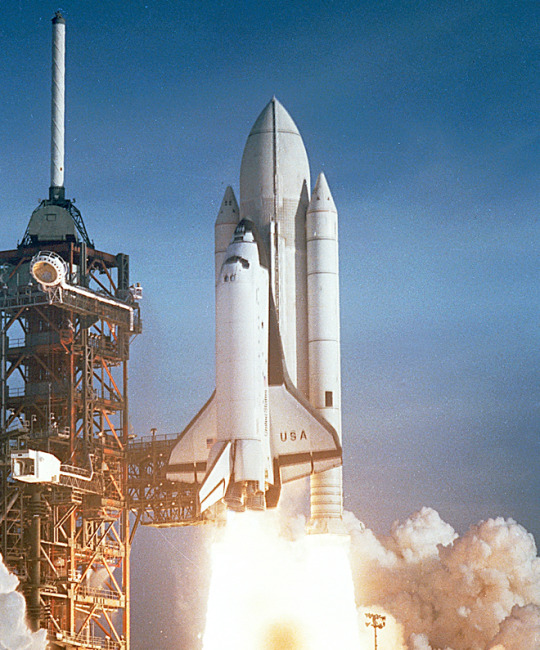
The Space Shuttle Orbiter Columbia lifts off at the start of STS-1.
The first Shuttle flight, designated STS-1, did not in fact lift off until April 12, 1981. As in the STS Flight Assignment Baseline document, OV-102 Columbia performed the OFT missions; OFT concluded, however, after only four flights. After the seven-day STS-4 mission (June 27 - July 4, 1982), President Ronald Reagan declared the Shuttle operational.
The first operational flight, also using Columbia, was STS-5 (November 11-16, 1982). The mission launched SBS-3 and Anik-C/3; because of Shuttle delays, the other SBS and Anik-C satellites planned for Shuttle launch had already reached space atop expendable rockets.
To the chagrin of many Star Trek fans, Enterprise never reached space. NASA decided that it would be less costly to convert Structural Test Article-099 into a flight-worthy Orbiter than to refit Enterprise for spaceflight after the ALT series. OV-099, christened Challenger, first reached space on mission STS-6 (April 4-9, 1983), which saw deployment of the first TDRS satellite.
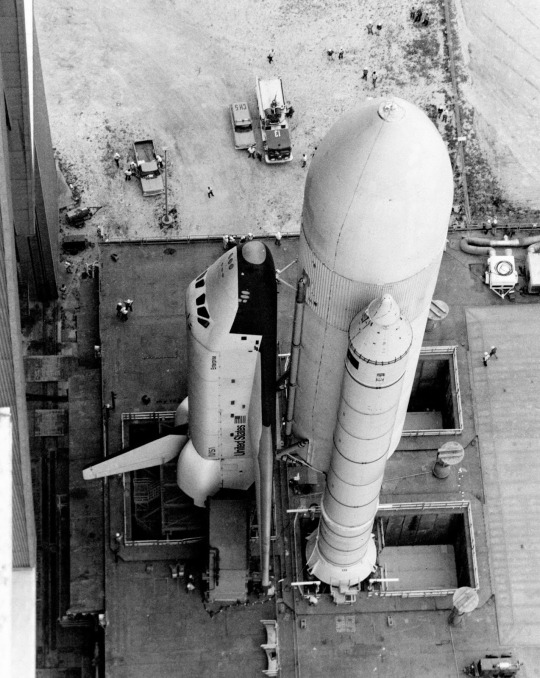
NASA put OV-101 Enterprise to work in a variety of tests and rehearsals (such as the 'fit check' shown in the image above), but did not convert it into a spaceflight-worthy Orbiter.
The voluminous Spacelab pressurized module first reached orbit on board Columbia on mission STS-9 (November 28- December 8,1983). The 10-day Spacelab 1 mission included ESA researcher Ulf Merbold and NASA scientist-astronauts Owen Garriott and Robert Parker. Garriott, selected to be an astronaut in 1965, had flown for 59 days on board the Skylab space station in 1973. Parker had been selected in 1967, but STS-9 was his first spaceflight.
The 21,500-pound LDEF reached Earth orbit on board Challenger on STS-41C, the 11th Space Shuttle mission (April 6-13, 1984). During the same mission, astronauts captured, repaired, and released the SMM satellite, which had reached orbit on 14 February 1980 and malfunctioned in January 1981. Challenger reached SMM without an OMS kit; in fact, no OMS kit ever reached space.
STS Flight Assignment Baseline document assumed that 22 Shuttle flights (six OFT and 16 operational) would occur before January 1982. In fact, the 22nd Shuttle flight did not begin until October 1985, when Challenger carried eight astronauts and the West German Spacelab D1 into space (STS-61A, October 30 - November 6, 1985). Three months later (28 January 1986), Challenger was destroyed at the start of STS-51L, the Shuttle Program's 25th mission.
In addition to seven astronauts — NASA's first in-flight fatalities — Challenger took with it TDRS-B, NASA's second TDRS satellite. The Shuttle would not fly again until September 1988 (STS-26, September 29 - October 3, 1988). On that mission, OV-103 Discovery deployed TDRS-C. The TDRS system would not include the three satellites necessary for global coverage until TDRS-D reached orbit on board Discovery on mission STS-29 (13-18 March 1989).
Following the Challenger accident, NASA abandoned — though not without some resistance — the pretense that it operated a fleet of cargo planes. The space agency had at one time aimed for 60 Shuttle flights per year; between 1988 and 2003, the Shuttle Program managed about six per year. The most flights the Shuttle fleet accomplished in a year was nine in 1985.
Shuttle delays meant that JOP, renamed Galileo, missed its early January 1982 launch window. It was eventually rescheduled for May 1986, but the Challenger accident intervened. Galileo finally left Earth orbit on 18 October 1989 following deployment from OV-104 Atlantis during STS-34 (October 18-23, 1989).
Between the time JOP/Galileo received its first funding and the Challenger explosion, NASA, the White House, and Congress had sparred over how the Jupiter spacecraft would depart Earth orbit. Eventually, they settled on the powerful liquid-propellant Centaur-G' rocket stage.
Citing new concern for safety following Challenger, NASA canceled Centaur G'. Galileo had to rely on the less-powerful IUS, which meant that it could not travel directly to Jupiter; it had instead to perform gravity-assist flybys of Venus and Earth to reach its exploration target. Galileo did not reach the Jupiter system until December 1995.
LDEF had been scheduled for retrieval in March 1985, less than a year after deployment, but flight delays and the Challenger accident postponed its return to Earth by nearly six years. On mission STS-32 (January 9-20, 1990), astronauts on board Columbia retrieved LDEF, the orbit of which had decayed to 178 n mi. LDEF remains the largest object ever retrieved in space and returned to Earth.
During reentry at the end of mission STS-107 (16 January-1 February 2003), Columbia broke apart over northeast Texas, killing its international crew of seven astronauts. This precipitated cancellation of the Space Shuttle Program by President George W. Bush, who announced his decision on 14 January 2004.
The end of the Space Shuttle Program was originally scheduled for 2010, immediately following the planned completion of the International Space Station. In the event, STS-135, the final Space Shuttle mission, took place four years ago (July 2011), three months after the 30th anniversary of STS-1. The Orbiter Atlantis lifted off on 8 July with a four-person crew — the smallest since STS-6. It docked with the International Space Station to deliver supplies and spares and landed in Florida 13 days later."
Article by David S. F. Portree: link
source, source
NASA ID: S77-5784, S77-5785, S77-5758
#STS-1#STS-2#STS-3#STS-4#STS-5#STS-6#STS-7#STS-8#STS-9#STS-10#STS-11#STS-12#STS-13#STS-14#STS-15#STS-16#STS-17#STS-18#STS-19#STS-20#STS-21#STS-22#STS-23#Space Shuttle Columbia#Columbia#OV-102#Space Shuttle Enterprise#Enterprise#OV-101#cancelled
29 notes
·
View notes
Text
swiftbridgers masterpost/timeline
DISCLAIMER: though the events of this timeline are accurate to real life, swiftbridgers is a completely satirical conspiracy theory that i made as a joke in december of 2022 before completely forgetting about it until may of 2023, i am very aware that both taylor and phoebe have boyfriends that are 6’5” and could squash me like a bug
that being said, please enjoy:
It all starts with a song.
A song called sidelines.
A song about a man named Paul Mescal that was used in a TV show starring a man named Joe Alwyn.
At the time of the songs release, these two men had (alleged) fiancés named Phoebe Bridgers and Taylor Swift, and these (alleged) fiancés have a song together, that song is called Nothing New.
Although, in December of 2022, the news that Phoebe and Paul have broken up is revealed by the one and only Daily Mail, which resulted in a lot of tweets like these:
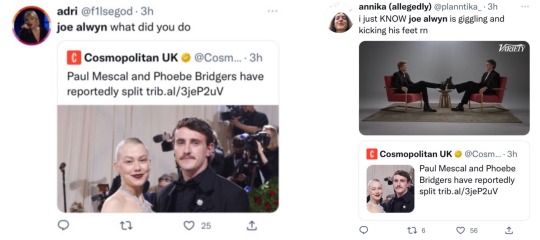
As at the time of the news breaking, Paul and Joe had just recently been on Variety’s Actors on Actors together, and about a month earlier it had been announced that Taylor and Phoebe were going on tour together in May of 2023, which gave us the first real photos of them together, which fans have affectionately nicknamed the “prom photos”


(keep May 2023 in mind, the bulk of this will take place in May)
Time-skip to March, 2023
On March 27th, Phoebe presented the innovator award to Taylor at the iHeartRadio awards, and not too long later Taylor posted about the release of Phoebe’s band boygenius’s album, the record. Unfortunately I can’t find screenshots of this anywhere, so this ask I sent to Jaime the other day and my memory are the only evidence I have
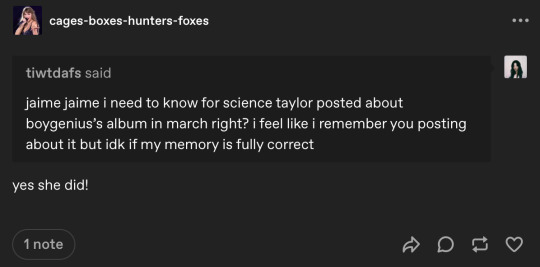
On April 8th, 2023, news broke that Taylor and Joe had split up after having been together 6 years. Some time later, on a date I have apparently completely repressed from my mind, news came out that Taylor was dating Matty Healy of the 1975.
I can’t remember if this was before or after the news broke, but whenever it was, I sent this to the discord

And so it began

May on Eras brought us a months worth of content revolving around the following:
Taylor backing away from Phoebe whenever she got within a certain distance of her, them staring longingly into each others eyes while singing the most devastating song you’ve ever heard, and most importantly, MEMES!!!



At the last show of Phoebe’s run on Eras, Taylor wore one of Phoebe’s Catbird necklaces, (and continued to do so pretty much until Travis Kelce entered the scene). In Taylor’s tweet about the MetLife shows she says, “@/phoebe_bridgers, I’ll miss you out here my dude, thanks for the duets and the dressing room heart to hearts 💕”
Since Taylor stopped wearing her jewelry, the only public interactions between the two have been via Phoebe’s Instagram Story (she posted “Slut!” on 1989 TV release day and Back to December on Taylor’s birthday) and that one time they went out to dinner in October or November.
so uh. yeah. there you have it! the complete swiftbridgers timeline. the seth meyers interview was left out on purpose because it doesn’t really link to all the rest of this. please refer to the powerpoint if you haven’t already!!
5 notes
·
View notes
Text


October 17, 1989
Hot In The Shade is released
Recorded: July–August 1989
Studio: The Fortress, Hollywood, California
Hot in the Shade is the fifteenth studio album by KIϟϟ, released in 1989. It is the first KIϟϟ studio album since 1981's Music From "The Elder" to feature lead vocals from someone other than Paul Stanley or Gene Simmons, with drummer Eric Carr singing lead on "Little Caesar". It is also the final KIϟϟ album in its entirety to feature Carr before his death in November 1991 during production of the band’s next album Revenge. Unlike its predecessor album, 1987's Crazy Nights, Hot in the Shade does not heavily feature keyboards. The album was recorded during the summer of 1989 at The Fortress in Hollywood. Aiming for a more stripped down sound, Gene and Eric reportedly decided to record the album there after checking out several different studios. To further give the album a more raw feel, along with being able to produce the album with a lower budget, the band elected to use the demos they recorded and polish them up via overdubs instead of re-recording the song over again. Some portions of Hot in the Shade, such as "Love's A Slap In The Face" were recorded using a drum machine to further reduce recording costs. For the parts that Eric and Kevin Valentine played drums on, electronic drum pads that triggered samples were used rather than a true drum kit, as The Fortress did not have one on hand.
The album includes the biggest hit of the band's non-makeup era, the power ballad "Forever", which was co-written by Stanley and Michael Bolton. The single reached No. 8 on the Billboard Hot 100 in April 1990, the band's highest charting single in the US since "Beth", 13 years earlier. Hot in the Shade was certified Gold on December 20, 1989 by the RIAA.
Hot in the Shade showcases a more straight-ahead sound, following the keyboard-centered pop-metal of Crazy Nights, and even flirts with speed metal on "Boomerang". It contains 15 songs, the most of any KIϟϟ studio album, and is one of the band's longest, with a running time of nearly an hour (58:39). Future band member Tommy Thayer co-wrote "Betrayed" and "The Street Giveth and the Street Taketh Away".
Three music videos were made for the promotion of the album: The first was "Hide Your Heart", a concept video filmed on the rooftop of the Hollywood Roosevelt Hotel in Los Angeles, directed by Marty Callner for Cream Cheese Productions. The second was "Rise to It" Gene and Paul appeared in KIϟϟ make-up for the first time since their 1983 unmasking for the video. Although the scene with gene and Paul in make-up was made to seem like it took place in 1975, the costumes they used were historically inaccurate; Gene's was from the Unmasked (1980) era while Paul's was from Love Gun (1977). The final video, "Forever," was also directed by Rezyka for Mark Freedman Productions and shot on December 16, 1989, in a building in downtown Los Angeles. Even though "Rise to It" was shot and edited before "Forever", "Forever" was released as the second music video from the album to take advantage of the radio airplay the ballad was receiving. The music video also reached No. 1 on Dial MTV and reached No. 47 on MTV's top 100 videos for 1990.
Of the 15 tracks on the album, only five were performed live. "Forever" was a pop hit and became a semi-regular part of the live setlist. "Hide Your Heart" was played in 2014 on the Kiss 40th Anniversary World Tour.
The album liner notes thanked a dozen KIϟϟ fan-published magazines that helped KIϟϟ fans connect with their favorite band and keep up to date with each member's activities. The liner notes concluded with a warning to fans about the HIV/AIDS epidemic, asking fans to use condoms to reduce the risk of catching and spreading it, adding, "AIDS is no party".
#kisstory#kiss#1989#hot in the shade#eric carr#bruce kulick#paul stanley#gene simmons#kiss band#kiss army#tommy thayer
58 notes
·
View notes
Text
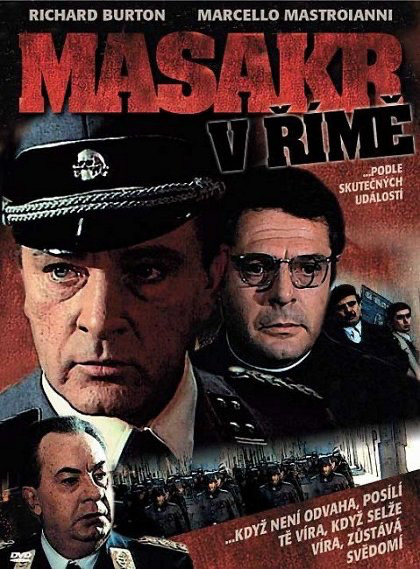

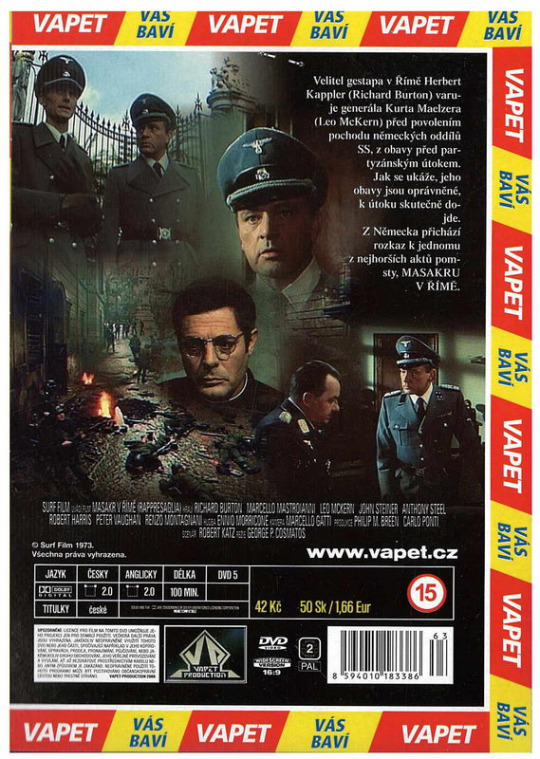


Rappresaglia 1973
Also Known As (AKA)
Argentina Masacre en Roma
Brazil (DVD title) Massacre em Roma
Brazil O Carrasco de Roma
Bulgaria (Bulgarian title)
Крьвопролитие в Рим
Denmark Massakren i Rom
Finland (Swedish title) Den stora massakern
Finland (TV title) Kostotoimi
Finland (video box title) Suuri joukkoteurastus
France Représailles
Greece (transliterated) Antipoina
Greece (reissue title) Sagi sti Romi
Greece (video title) | sfagi
Hungary Megtorlás
Ireland (English title) Massacre in
Rome
Mexico (complete title) Masacre en
Roma
Norway Massakren i Rom
Poland Masakra w Rzymie
Portugal Massacre em Roma
Romania Masacru la Roma
Soviet Union (Russian title)
Репрессалии
Spain Muerte en Roma
Sweden Den stora massakern
UK Massacre in Rome
USA Massacre in Rome
West Germany Tödlicher Irrtum
West Germany Das Massaker - Der Fall
Kappler
Release Dates
Italy 4 October 1973
USA 24 October 1973
Denmark 19 August 1974
Sweden 23 March 1975
UK July 1975
Norway 14 July 1975
Finland 12 December 1975
France 22 June 1976
West Germany 10 June 1977
Sweden 30 March 2004 (DVD premiere)
Filming Dates 13 November 1972
Regista: George Pan Cosmatos
Music by Maestro Ennio Morricone
Bruno Nicolai ... conductor
Produttore: Carlo Ponti
technical specifications
Runtime 1 hr 50 min (110 min)
Interpreti e personaggi
Marcello Mastroianni: padre Antonelli
Richard Burton: Herbert Kappler
Renzo Montagnani: Questore Pietro
Caruso
John Steiner: Eugen Dollmann
Delia Boccardo: Elena
Duilio Del Prete: partigiano
Giancarlo Prete: Paolo
Peter Vaughan: Albert Kesselring
Renzo Palmer: Giorgio
Leo McKern: Kurt Mälzer
Guidarino Guidi: Guido Buffarini Guidi
Robert H. Harris: padre Pfeiffer
Douglas Hare: giovane soldato tedesco
Jacques Herli: Giovanni
Massimo Sarchielli: primo partigiano
alla finestra
Anthony Steel: maggiore Domizlaf Brook Williane: capitane Erich Priebke
#rappresaglia#massacre in rome#george pan cosmatos#marcello mastroianni#richard burton#delia boccardo#war movie#war movies#giallofever#giallo#giallo fever#gialli#italian giallo#italian cult#cinema cult#cult#international cult
2 notes
·
View notes
Text
THIS DAY IN GAY HISTORY
based on: The White Crane Institute's 'Gay Wisdom', Gay Birthdays, Gay For Today, Famous GLBT, glbt-Gay Encylopedia, Today in Gay History, Wikipedia, and more … December 23


1631 – The English Elizabethan poet Michael Drayton died on this date (b.1563). In 1593 appeared the first of Drayton's historical poems, "The Legend of Piers Gaveston" which dealt with the relationship between the English King Edward II and Gaveston in sympathetic terms that did not condemn their love. Drayton moved in the circle of writers that included Christopher Marlowe and Drayton's play may have had an influence on Marlowe's version which came out the following year in 1594.


1777 – Tsar Alexander I of Russia was born on this date (d.1825). Alexander's Russia is the backdrop for Tolstoy's War and Peace, so complicated is this period of European history. Basically, Alexander may be seen as the emperor of Russia who formed the coalition that defeated Napoleon and founded the Holy Alliance. The church bells you hear at the end of Tchaikovsky's 1812 Overture are ringing out at the news of Alexander's defeat of France, which made him one of the most powerful leaders in Europe.
Is it any wonder Napoleon called Alexander "the slyest and handsomest of all the Greeks," a begrudgingly admiring assessment of the czar's homosexuality, a contention amply supported in the documents of the period. Alexander was always shrouded in mystery. When he died, rumors persisted that he had actually fled Russia to Siberia where he became a hermit. In 1926 his tomb was opened by the Soviet government. It was empty and the mystery remains unresolved.

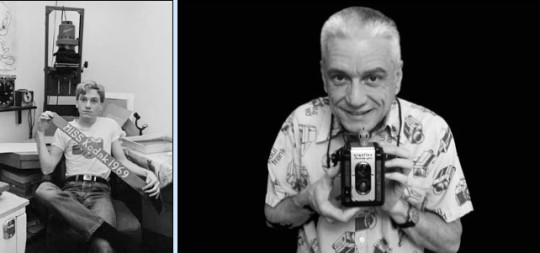
1954 – Danny Nicoletta is an American photographer, photo journalist and gay rights activist.
Born in New York City, Daniel Nicoletta was raised in Utica, NY. In his late teens he left New York to attend San Francisco State University, later graduating from the bachelor of arts program. He started his photographic career in 1975 as an intern to Crawford Barton, who was then a staff photographer for the national gay magazine The Advocate.
In 1974, when he was 19, Nicoletta first met Harvey Milk and Scott Smith at Castro Camera, their camera store on Castro Street; the following year, they hired him to work at shop. The three became friends, and Nicoletta worked with Milk on his campaigns for political office. During this period of time, Nicoletta took many now well-known photographs of Milk.

After Milk's death, Nicoletta worked to keep his memory alive. He was the installation coordinator of the Harvey Milk photographic tribute plaques installed at Harvey Milk Plaza and at the Castro Street Station, which featured his photographs as well as those of Marc Cohen, Don Eckert, Jerry Pritikin, Efren Ramirez, Rink, and Leland Toy. He was co-chair of the Harvey Milk City Hall Memorial Committee, and his photograph served as the basis for the bust of Milk that now resides in the rotunda of San Francisco's City Hall.
In the feature film Milk, a biographical film based on the life of Harvey Milk directed by Gus Van Sant, Nicoletta is played by Lucas Grabeel. Nicoletta himself plays Carl Carlson and served as the still photographer on the film.
Nicoletta was one of the founders of the San Francisco International LGBT Film Festival, now known as the Frameline Film Festival. In 1977, while still working at Harvey Milk's photography shop, Nicoletta, along with David Waggoner, Marc Huestis, and others, began film screenings of their Super 8 films, called the Gay Film Festival of Super 8 Films, which evolved into the yearly festival.


1970 – The film Little Big Man was released on this date. Directed by Arthur Penn, it was one of the year's top grossing films. Of particular interest was actor Robert Little Star's portrayal of "Little Horse", a Transgendered Native American who was well accepted by his peers. This was one of the first popular recognitions of a tradition of sexual diversity among Plains Indian nations.


1980 – Rory O'Malley is an Irish-American film, television, and musical theater actor, best known for his Tony Award-nominated performance as Elder McKinley in The Book of Mormon. He is a co-founder of the gay rights activism group Broadway Impact.
O'Malley was featured in the Dustin Lance Black play, '8', on Broadway as Ryan Kendall and in the Los Angeles premiere as Dr. Gregory M. Herek — witnesses in the federal case that overturned California's Proposition 8.
In 2012, O'Malley and his boyfriend Gerold Schroeder were featured in a GAP ad, cheek to cheek, with the caption "BE ONE."
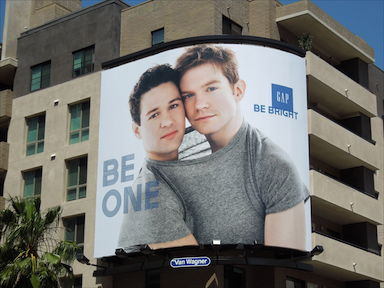
On July 21, 2013, O'Malley announced that he is engaged to his boyfriend of five years, Gerold Schroeder. On September 28, 2014, Rory and Gerold were married.
O'Malley is an active supporter of gay rights, establishing the activism group Broadway Impact in 2009 with Gavin Creel and Jenny Kanelos. O'Malley said of the group in late 2010:
"[S]ince its first year, Broadway Impact has held massive rallies for equality in New York City, made thousands of calls through phone banks and even organized 25 buses to Washington, D.C. so that 1,400 people could attend the National Equality March for free. This year we were honored to receive the 2010 Human Rights Campaign Community Award and even participated in the ING New York City Marathon as a charity team. Our team of 12 runners, including myself, raised $38,440 for Broadway Impact!"Openly gay, he came out at the age of 19. In an April 2011 interview with O'Malley said, "Life comes before the business...Maybe some actors haven't gotten a role because they came out, but who gives a shit if you aren't happy? I do have it easier because I'm not a leading man, but I can't imagine having the energy to be in the closet. Besides, gay actors who start up gay organizations can't exactly get away with it." He currently resides in New York City with his husband Gerold. O'Malley remains good friends with Book of Mormon co-star and former college roommate Josh Gad.

1993 – Philadelphia starring Tom Hanks premieres. The film is an American drama and one of the first mainstream Hollywood films to acknowledge HIV/AIDS, homosexuality, and homophobia. It was written by Ron Nyswaner, directed by Jonathan Demme and stars Tom Hanks and Denzel Washington. Hanks won the Academy Award for Best Actor for his role as Andrew Beckett in the film, while the song "Streets of Philadelphia" by Bruce Springsteen won the Academy Award for Best Original Song.

1998 – Chile decriminalizes consensual sodomy.

2009 – The Chief Justice of Pakistan orders the National Database & Registration Authority to issue national identity cards showing "distinct" gender allowing hijras to register as a separate gender.


5 notes
·
View notes
Text
Don’t Dictate: How DIY Punk Changed Music
Defiantly anti-establishment, punk’s DIY stance shocked the music industry in the 70s, but its influence can still be felt today – as uDiscover reveals.
Published on August 1, 2016 By Tim Peacock
After the UK’s premier punks, Sex Pistols, lambasted presenter Bill Grundy during their expletive-stuffed slot on Thames TV’s Today show in December 1976, the music industry received a short – but very sharp – shock.
Daily Mirror Filth And The Fury Headline - 300The immediate fallout was far-reaching. With the press having a field day, Sex Pistols became household names overnight, and the term “punk” (previously of cult-level interest) suddenly gained widespread exposure. Petrified promoters duly cancelled most of Sex Pistols’ scheduled Anarchy UK tour dates, and, early in January ’77, a beleaguered EMI eventually dropped the band from their roster, reputedly paying £40,000 for the privilege.
Suddenly, punk appeared too hot to handle. Yet while this defiant new genre’s very existence apparently posed a threat to the music industry’s established status quo, it ultimately dissipated with a whimper, rather than a bang. Having eventually signed to Virgin Records, Sex Pistols split in disarray in January ’78; their nearest rivals, The Clash, set their sights on America; by the turn of the 80s, “punk” had been neutered and hijacked by hordes of identikit, Mohican-sporting Exploited clones.
Punk Politics: Fighting The Power, From Sex Pistols To Anti-Flag
‘Metal Box’: Lifting The Lid On Public Image Ltd’s Seminal Second Album
‘Autoamerican’: How Blondie Became ‘The Most Modern Band’ On Earth
The Beatles - Now And Then
Sniffin' Glue - Now Form A Band - 300However, one aspect of punk’s anti-establishment ideology endures to this day: its inherent DIY ethos, most often identified with the quintessential punk commandment: “This is a chord, this is another, this is another… now form a band!” Incorrectly attributed to Mark Perry’s seminal punk fanzine Sniffin’ Glue (the quote actually appeared, along with the relevant chord shapes, in the January ’77 edition of punk ’zine, Sideburns), this impassioned plea to create – and promote – music independently is always associated with 1976, yet there are pre-punk precedents. In North America, for example, Californian power-pop label Beserkley had been operating outside of the mainstream since 1973, while Cleveland’s avant-garde pioneers Pere Ubu released their landmark debut single ‘30 Seconds Over Tokyo’ on their own Hearthan label in 1975.
DIY, however, figured prominently in punk’s manifesto right from the start.
2 notes
·
View notes
Photo

Artist - キャンディーズ (Candies)
Song - ハートのエースが出てこない (Heart No Ace Ga Detekonai) [Eng. “I Can't Get The Ace Of Hearts”]
Release Date - December 1975
Listen 🎶
https://rumble.com/v1quqrw-candies-heart-no-ace-ga-detekonai.html
My blog: Showa Music Library
https://nobbykun.tumblr.com/
2 notes
·
View notes
Text
Knock knock on heavens door


Gabrielle's single " Rise" (2000) sampled from this song. In addition to the versions already mentioned above, other notable covers include those by Neil Young, Lana Del Rey, Nick Cave, Patti Smith, Paul Simon, Bono, Antony and the Johnsons, Warren Zevon, Cat Power, Roger Waters, Tanya Donelly, Jerry Garcia, Avril Lavigne, Wyclef Jean, Television, Nina Hagen, Mudcrutch and Low. "Knockin' on Heaven's Door" has been covered by over 150 artists. The song was featured on the compilation album Hits 97, where all royalties from the song were given to three charities. The proceeds went to charities for children. 1 on the UK and Scottish Singles Charts, as well as No.


This version of the song, featuring children from the village singing the chorus with the guitarist and producer of Dylan's album Infidels (1983), Mark Knopfler, was released on December 9, 1996, in the United Kingdom and reached No. This has been, according to some sources, one of the few times Dylan has officially authorized anybody to add or change the lyrics to one of his songs. In 1996 and with the consent of Dylan, Scottish musician Ted Christopher wrote a new verse for "Knockin' on Heaven's Door" in memory of the schoolchildren and teacher killed in the Dunblane school massacre. ^ Shipments figures based on certification alone.ĭunblane tribute "Knockin' on Heaven's Door" Axl Rose – lead vocals, backing vocals, pianoĭecade-end charts Chart (1990–1999) The music video for this version of the song was directed by Andy Morahan. Another version was released on the video Use Your Illusion World Tour - 1992 in Tokyo II. Their performance of the song at the Freddie Mercury Tribute Concert in 1992 was used as the B-side for the single release and was also included on their Live Era: '87–'93 album, released in 1999. 1, it became Guns N' Roses' third (and to date last) number-one single as well as their ninth consecutive top-five hit. In Ireland, where the song also reached No. Elsewhere, the single topped the charts of Portugal, Belgium, and the Netherlands it was the best-selling song of 1992 in the latter country. 2 on the UK Singles Chart and the New Zealand Singles Chart. Released as the second single from the album, it reached No. This version was slightly modified for the band's 1991 album Use Your Illusion II, discarding the responses in the second verse. 18 on the US Billboard Album Rock Tracks chart and No. They recorded and released a studio version in 1990 for the soundtrack of the film Days of Thunder that reached No. A live version of the song was released on the 12-inch single of " Welcome to the Jungle" the same year. In 1987, American hard rock band Guns N' Roses started performing the song. Guns N' Roses versions "Knockin' on Heaven's Door"įrom the album Days of Thunder (soundtrack) Several Clapton compilation albums also feature the song. There were also performances of the song included on the Journeyman (1990) and the One More Car, One More Rider (2003) world tours. Clapton's 1996 boxed set Crossroads 2: Live in the Seventies features a performance of the song recorded in London in April 1977. 38 on the UK charts, but the single was less successful in the U.S where it failed to chart on the Billboard Hot 100 (although it reached on No. After the recording sessions with Louis, Clapton recorded his own version of the song which was released as a single in August 1975 two weeks after Louis's version. In January 1975 Eric Clapton played on Arthur Louis's recording of " Knockin' on Heaven's Door" which was arranged in a cross-over reggae style.
Thirty-Nine Years of Great Concert PerformancesĮric Clapton and Arthur Louis versions.
The 30th Anniversary Concert Celebration.
Some of these versions have appeared on Dylan's live and Bootleg Series albums including: Sales+streaming figures based on certification alone.Īccording to his website, Dylan has performed the song in concert 460 times between its live debut in 1974 and its last outing in 2003. Note: When you embed the widget in your site, it will match your site's styles (CSS).West Germany ( Official German Charts) Get the embed code RAIGN - Knocking On Heavens Door - EP Album Lyrics1.Don't Let Me Go2.Empire of Our Own3.Knocking on Heavens Door4.Wicked GamesRAIGN Lyrics provided by And I'm feel like I'm knockin' on heaven's doorĪnd I feel like I'm knockin' on heaven's door

3 notes
·
View notes
Text
TIMELINE
1905 - first Russian revolution, Freud's theory of sexuality, Potemkin incident
1912 - Stanislawski's acting method is created.
1914- assassination of Archduke Franz Ferdinand of Austria, beginning of World War I.
1915- Franz Kafka, The Metamorphosis
1916- Zurich, Cabaret Voltaire
1917 - Bolshevik Revolution
1918 - Assassination of the Tsar and the Romanov family
1922 - March on Rome and coming to power of Mussolini
1929 - Mayakovsky's bug. Prisypkin is frozen as a result of a fire during his wedding.
1930 - Mayakovsky's suicide.
1931- Second Spanish Republic
1932-33- Great famine in Ukraine, Holodomor (famine). Between 3 and 5 million people died.
1933- Hitler comes to power in Germany.
1936- Spanish Civil War. Murder of García Lorca.
1938 - Kristallnacht (Night of Broken Glass).
1939 - Invasion of Poland and beginning of World War II.
1940 - Torutra and execution of Vsevolod Meyerhold.
1945 - The US drops two nuclear bombs on Hiroshima and Nagasaki in Japan.
1947 - For the first time, insects are launched into space: In 1947, the United States sends fruit flies (Drosophila melanogaster) into space aboard a V2 rocket. They were the first animals in space and were part of a series of experiments to study the effects of cosmic rays on living organisms.
1948 - Nakba, and creation of the state of Israel.
1955 - First documenta in Kassel.
1955 - First Israeli raid on Gaza.
1959 - First color TV broadcast
1960 - The contraceptive pill for women is marketed.
1961 - First man launched into space: Yuri Gagarin
1968 - Tlatelolco Tragedy, French May
1969 - Riots at the Stone Wall
1971 - Commercialization of the first Intel 4004 microchip. Abandonment of the gold standard by Richard Nixon.
1975 - Thrilla in Manilla, Muhammad Ali faces Joe Frazier.
1978 - The Russian-Afghan war begins. It will end in 1992.
1979 - Prisypkin wakes up. The Clockwise Experiment: This concept was first developed and tested in 1979 in Ellen Langer's "counterclockwise" study, which examined the psychological effects of turning back the clock on the physiological state of an older adult. The research question was, "If we set the mind back twenty years, will the body reflect this change?".
1981- AIDS crisis, Michelangelo Miccolis is born.
1989- Fall of the Berlin Wall. Tiananmen Square, protests and massacre. Francis Fukuyama publishes "The End of History". Creation of the World Wide Web.
1990 - Nelson Mandela is released from prison.
1992 - Maastricht Treaty
1997 - Death of Princess Diana of Wales.
1999 - Putin comes to power in Russia.
2000 - Y2K. Y2K was a computer glitch, or bug, that may have caused problems when dealing with dates after December 31, 1999.
2001 - 9/11
2003- Beyoncé releases "Dangerously in Love". Beyoncé is 21 and already dating Jay Z.
2007 - #metoo
2008 - War in Georgia
2009 - Ru Paul's drag race
2011 - Arab Spring. 11M
2014 - Russia invades Donbas and annexes Crimea.
2016 - Murder of eco-activist Berta Cáceres.
2017 - Hollywood's #metoo
2018 - First Fridays for Climate Greta Thumberg strikes.
2020 - COVID. Murder of George Floyd
2022 - Rihanna's son is born. Russia invades Ukraine and war begins. Decriminalization of sex work in Belgium. The first person who does not die is born. Jan Fabre is found guilty of sexual harassment. Spanish government approves trans law recognizing free gender self-determination.
NOW
2030 - The increase in global temperature is irreversible.
2031 - Third Spanish Republic
2032 - There is one person left on facebook
2039- Crypto Crash
2050 - Ecological Collapse
2060- End of Capitalism
3,050 - Days lengthen by 1/30th of a second
10,000 - Extinction of humanity. The water level rises by 5 m in relation to the present.
1 note
·
View note
Text
G.R. No. L-68470 October 8, 1985
ALICE REYES VAN DORN, petitioner,
vs.
HON. MANUEL V. ROMILLO, JR., as Presiding Judge of Branch CX, Regional Trial Court of the National Capital Region Pasay City and RICHARD UPTON respondents.
Alice Reyes Van Dorn, petitioner seeks to set aside the Orders, dated September 15, 1983 and August 3, 1984, in Civil Case No. 1075-P, issued by respondent Judge, which denied her Motion to Dismiss said case, and her Motion for Reconsideration of the Dismissal Order, respectively.
Facts :
This case is about an American and a Filipina who got married and had 2 children. Alice Reyes and Richard Upton were married in Hongkong in 1972; that, after the marriage, they established their residence in in the Philippines and had 2 children on April 4, 1973 and December 18, 1975, respectively; that the parties were divorced in Nevada, United States, in 1982; and that petitioner has re-married also in Nevada, this time to Theodore Van Dorn
In 1983 ,Upton, private respondent filed suit against petitioner in Civil Case No. 1075-P of the Regional Trial Court, Branch CXV, in Pasay City, stating that petitioner's business in Ermita, Manila, (the Galleon Shop, for short), is conjugal property of the parties, and asking that petitioner be ordered to render an accounting of that business, and that private respondent be declared with right to manage the conjugal property.
Petitioner moved to dismiss the case on the ground that the cause of action is barred by previous judgment in the divorce proceedings before the Nevada Court wherein respondent had acknowledged that he and petitioner had "no community property" as of June 11, 1982.
The Court below denied the Motion to Dismiss in the mentioned case on the ground that the property involved is located in the Philippines so that the Divorce Decree has no bearing in the case. The denial is now the subject of this certiorari proceeding.
Issue :
What is the effect of the foreign divorce on the parties and their alleged conjugal property in the Philippines?
Ruling :
The petition is granted and respondent judge was ordered to dismiss the complaint by the husband CIVIL CASE 1075 P.
In this case, the divorce in Nevada released private respondent from the marriage from the standards of American law, under which divorce dissolves the marriage. Thus pursuant to his national law, private respondent is no longer the husband of petitioner. He would have no standing to sue as petitioner’s husband entitled to exercise control over conjugal assets. As he is bound by the Decision of his own country’s Court, which validly exercised jurisdiction over him, and whose decision he does not repudiate, he is estopped by his own representation before said Court from asserting his right over the alleged conjugal property.
0 notes
Text
youtube
Still Wakes The Deep gets new trailer, no release date specified
A new trailer has been released for Still Wakes The Deep. No release date was specified.
December 1975. Disaster strikes the Beira D oil rig off the coast of Scotland. Navigate the collapsing rig to save your crew from an otherworldly horror on the edge of all logic and reality.
0 notes
Text


Source: Disco 45 magazine, issue 50
Date: December 1974
From my own collection
(Transcript Below)
WATCH OUT for Merlin…
They're a comin' band who are going assail quite several eardrums (in the nicest, most musical way) and blow open a few minds in 1975. They're called Merlin…
Certainly, if their current single, 'Wild Cat' (CBS) is anything to go by they're going to be serious chart contenders, too. Dramatic vocal work, stomping beat, nice sense of dynamics, ideal song and first-class production. The kind of disc, in fact, which cries out for acceptance on a widespread scale.
Indeed, Merlin's very first single for CBS - the equally exciting '(Let Me) Put My Spell On You' - had the hallmark of Chartworthy material. But like so many other good records, it didn't really do much across the record counters.
'Wild Cat' could well do the trick for this London-based band which started its life as Madrigal it changed to Merlin in February of this year.
Merlin line up thus: Alan Love, (22), vocals; Gary Alice Strange, (22), bass, guitar, vocals; Jamie Moses, (19), lead guitar, vocals; Scully Wagon-Lits, (21), keyboards, guitar, vocals, and David Wightwick, (24), drums, vocals.
Merlin, as their three CBS singles released thus far, are a very tight, together outfit - and, we are told, were always that way, right from their earliest days. Drummer Wightwick, born in Dunstable, Beds., is in many ways the driving force behind Merlin. Hampstead-born bassist Strange's throbbing is a perfect addition to the rhythm cauldron, and the fantastically-named Scully Wagon-Lits blends his keyboard sounds intriguingly with these two and guitarist MOses' spiralling guitar lines. Out front, Alan Love's exciting vocals project the right kind of audience-artist communication.
Anyone who was fortunate enough to catch Merlin at one of their concerts during their 47-date British tour in early 1974 will be sure to testify as to their great potential. Some idea of their musical excellence - without the visual aspect, of course - can be gauged from their debut LP called, simply, "Merlin". It's chockful of good things.
Merlin could well turn out to be one of 1975's more pleasant surprises in the music business. Be sure you're around when they really hit the bit time…
1 note
·
View note
Link
#AliceCooper#belmontcounty#BrookeCounty#downtownwheeling#ohiocounty#UpperOhioValley#WesbancoArena#wheeling
0 notes
Text
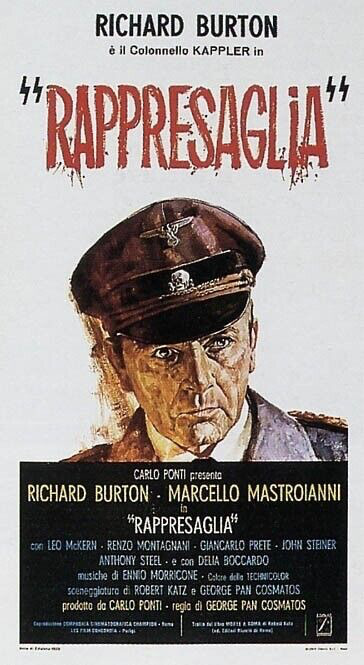
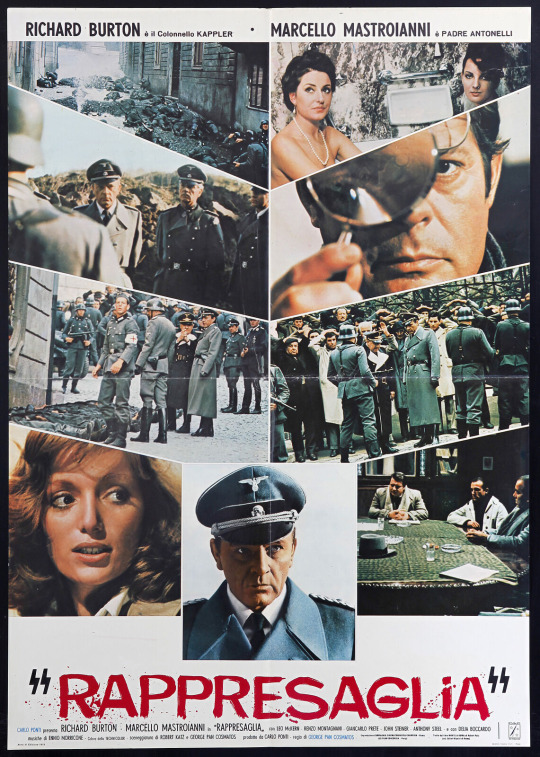

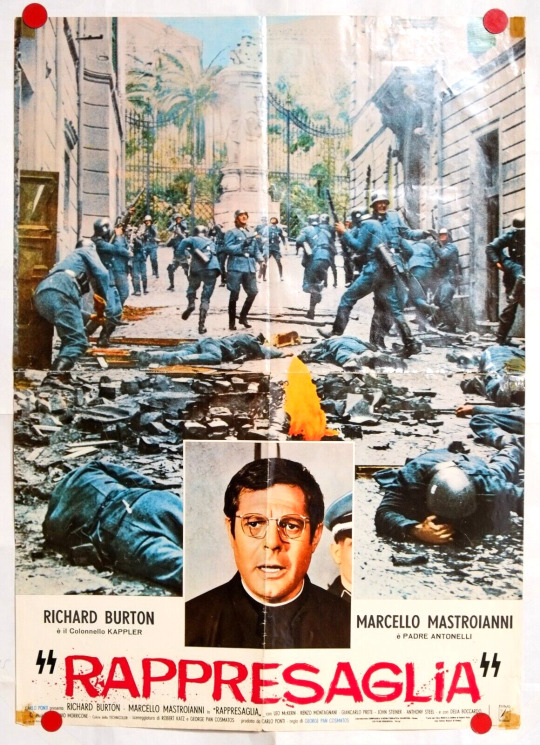

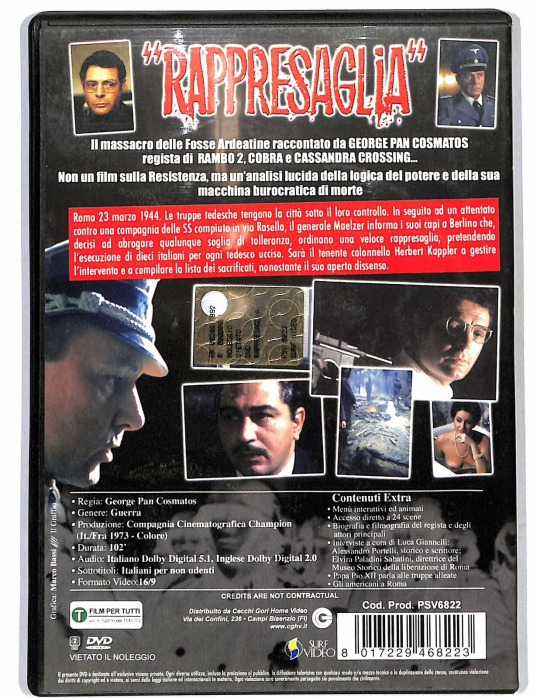



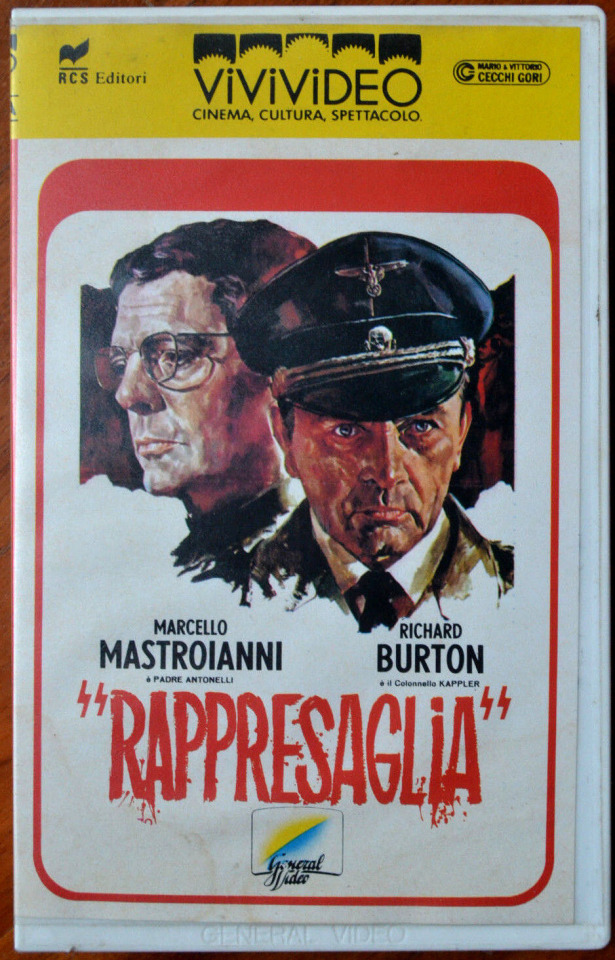
Rappresaglia 1973
Also Known As (AKA)
Argentina Masacre en Roma
Brazil (DVD title) Massacre em Roma
Brazil O Carrasco de Roma
Bulgaria (Bulgarian title)
Крьвопролитие в Рим
Denmark Massakren i Rom
Finland (Swedish title) Den stora massakern
Finland (TV title) Kostotoimi
Finland (video box title) Suuri joukkoteurastus
France Représailles
Greece (transliterated) Antipoina
Greece (reissue title) Sagi sti Romi
Greece (video title) | sfagi
Hungary Megtorlás
Ireland (English title) Massacre in
Rome
Mexico (complete title) Masacre en
Roma
Norway Massakren i Rom
Poland Masakra w Rzymie
Portugal Massacre em Roma
Romania Masacru la Roma
Soviet Union (Russian title)
Репрессалии
Spain Muerte en Roma
Sweden Den stora massakern
UK Massacre in Rome
USA Massacre in Rome
West Germany Tödlicher Irrtum
West Germany Das Massaker - Der Fall
Kappler
Release Dates
Italy 4 October 1973
USA 24 October 1973
Denmark 19 August 1974
Sweden 23 March 1975
UK July 1975
Norway 14 July 1975
Finland 12 December 1975
France 22 June 1976
West Germany 10 June 1977
Sweden 30 March 2004 (DVD premiere)
Filming Dates 13 November 1972
Regista: George Pan Cosmatos
Music by Maestro Ennio Morricone
Bruno Nicolai ... conductor
Produttore: Carlo Ponti
technical specifications
Runtime 1 hr 50 min (110 min)
Interpreti e personaggi
Marcello Mastroianni: padre Antonelli
Richard Burton: Herbert Kappler
Renzo Montagnani: Questore Pietro
Caruso
John Steiner: Eugen Dollmann
Delia Boccardo: Elena
Duilio Del Prete: partigiano
Giancarlo Prete: Paolo
Peter Vaughan: Albert Kesselring
Renzo Palmer: Giorgio
Leo McKern: Kurt Mälzer
Guidarino Guidi: Guido Buffarini Guidi
Robert H. Harris: padre Pfeiffer
Douglas Hare: giovane soldato tedesco
Jacques Herli: Giovanni
Massimo Sarchielli: primo partigiano
alla finestra
Anthony Steel: maggiore Domizlaf Brook Williane: capitane Erich Priebke
#rappresaglia#massacre in rome#marcello mastroianni#george pan cosmatos#richard burton#war movies#war movie#delia boccardo#giallofever#giallo#giallo fever#gialli#italian giallo#italian cult#cinema cult#cult#international cult
2 notes
·
View notes
Text
On this date in music history…I’m so embarrassed that I even know who PSY is…or was…
December 21st
2016 - Richard Marx
American singer Richard Marx told of how he had to restrain a fellow passenger on a Korean Air flight after the man, who was drunk allegedly attacked others onboard. The incident happened as Marx and his wife were travelling from Hanoi to Seoul. The man was arrested upon landing in South Korean.
2014 - Elton John
Sir Elton John and his partner David Furnish formally converted their civil partnership to a marriage hosting a ceremony at their Windsor estate in Berkshire. David and Victoria Beckham, Ed Sheeran, Lulu and actor David Walliams were among the guests.
2012 - Ronnie Wood
Rolling Stones guitarist, 65-year-old Ronnie Wood married his fiancee Sally Humphreys during a private ceremony in London. Keith Richards, Rod Stewart and Paul McCartney all attended the wedding.
2012 - Psy
'Gangnam Style' by South Korean musician Psy became the first YouTube video to reach a billion views. By the end of 2012, the song had topped the music charts of more than 30 countries.
2012 - Paul Simon
Paul Simon performed his classic track 'The Sound of Silence' at the funeral of a teacher who died in the school shooting in Connecticut on 14 December of this year. The 1966 song was understood to be a favourite of 27-year-old Victoria Soto, a first-grade teacher at Sandy Hook Elementary School. The singer, a family friend, performed the song in front of some 400 mourners, at Soto's local church on Wednesday. Twenty six people were killed in the mass shooting the previous week.
2005 - Elton John
Sir Elton John and his partner David Furnish became the first gay celebrities to register their relationship as a civil partnership. The 20 minute ceremony took place at The Guild Hall, Windsor, England, guest’s included Ringo Starr, Victoria Beckham, Joss Stone, Sting, Elvis Costello, Jamie Cullum, George Michael and The Osbournes - Ozzy, Sharon, Jack and Kelly.
2003 - The Riffathon
Tommy Hubbard from Whitby, aged 14, won the 2003 Riffathon, a nationwide guitar competition in aid of Action For Brazil's Children Trust. The final was held at the University of Surrey and was judged by Jimmy Page and Brian May. The ten Riffathon finalists each performed a Led Zeppelin classic track with a full live band. Tommy's performance of 'Ramble On' won him the star prize of a 1958 re-issue Gibson Les Paul standard guitar, donated by Gibson Guitars.
1998 - Karl Denver
Scottish singer Karl Denver died from a brain tumour aged 67. Had the 1962 UK No.4 single 'Wimoweh' and 1990 UK hit 'Lazyitis- One Armed Boxer' with Happy Mondays.
1996 - Knockin' on Heaven's Door
The charity record 'Knockin' on Heaven's Door' went to No.1 on the UK singles chart. With the consent of Bob Dylan musician Ted Christopher of Dunblane, Scotland wrote a new verse for the song in memory of the schoolchildren and teacher killed in the Dunblane massacre. The cover version of the song included brothers and sisters of the victims singing the chorus and Mark Knopfler on guitar.
1992 - Albert King
American blues singer and guitarist, Albert King died from a heart attack in Memphis, Tennessee. He recorded dozens of influential songs, such as 'Crosscut Saw' and 'As The Years Go Passing By', and the 1967 album, 'Born Under a Bad Sign.'
1991 - Freddie Mercury
'Bohemian Rhapsody - 'These Are The Days Of Our Lives' by Queen started a five week run at No.1 in the UK, the 1975 word-wide hit had been re-released following the death of Freddie Mercury.
1985 - Bruce Springsteen
Bruce Springsteen's album, Born in the USA passed Michael Jackson's Thriller to become the second longest-lasting LP on the Billboard US Top 10. It stayed there for 79 weeks. Only The Sound of Music with Julie Andrews lasted longer at 109 weeks.
1970 - Elvis Presley
A stretch limousine carrying Elvis Presley pulled up outside the White House in Washington, D.C. The driver handed over a letter from Elvis addressed to President Nixon requesting a meeting to discuss how the King of Rock and Roll could help Nixon fight drugs. The President agreed to give Presley a Narcotics Bureau badge - but only after learning that the chief of the narcotics bureau had turned down the same request earlier that day and told Presley the only person who could overrule his decision was the President. At Elvis' request, the meeting remained secret for more than a year, until the Washington Post broke the story on January 27th, 1972.
1967 - The Beatles
The Beatles held a party at the Royal Lancaster Hotel in London to preview their new movie ‘Magical Mystery Tour’.
1967 - Pink Floyd
Pink Floyd appeared at the Speakeasy Club, London, England. Situated at 48 Margaret Street in the centre of London, the Speakeasy was a late-night haunt for the music industry from 1966 right up to to the late 1970s. It was managed by Laurie O'Leary (a lifelong friend of the Kray twins) from 1968 to 1977 and Roy Flynn, who was also the first manager of Yes
0 notes